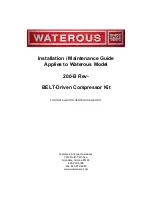
19
BRAD/STAPLER
SPECIFIC SAFETY RULES
a) If not used correctly and without suitable
maintenance, the brad/stapler can cause serious injury.
b) Always wear goggles and ear plugs when using the
brad/stapler.
c) Handle the brad/stapler holding it firmly by the grip
only.
d) Always disconnect the tool from the air supply
when unattended, performing any maintenance or
repair, clearing a jam, or moving the tool to a new
location.
Do not load the tool with nails when either
the trigger is depressed or the Protector (Fig. 13 - A) is
engaged. The tool could eject a nail causing death or
serious personal injury.
e) Always fit tool with a fitting or hose coupling on or near
the tool in such a manner that all compressed air in the
tool is discharged at the time the fitting or hose coupling is
disconnected. Do not use a check valve or any other fitting
which allows air to remain in the tool. Death or serious
personal injury could occur.
f) Never place hands or any other body parts in the
nail discharge area of the tool.
The tool might eject a
nail and could result in death or serious personal injury.
g) Do not touch the trigger unless driving nails.
Never
attach air line to tool or carry tool while touching the
trigger. The tool could eject a nail which will result in death
or serious personal injury.
h) Always assume the tool contains nails.
Respect
the tool as a working implement; no horseplay. Always
keep others at a safe distance from the work area in case
of accidental discharge of nails. Do not point the tool
toward yourself or anyone whether it contains nails or not.
Accidental triggering of the tool could result in death or
serious personal injury.
i) Do not nail on top of another nail.
This is able to
cause the nail to be deflected and hit someone, or cause
the tool to react and result in a risk of injury to persons.
j) Do not drop or throw the tool.
Dropping or throwing
the tool can result in damage that will make the tool
unusable or unsafe. If the tool has been dropped or
thrown, examine the tool closely for bent, cracked or
broken parts and air leaks. STOP and repair before using
or serious injury could occur.
k) Always check that the protector (A) is operating
properly.
A nail could accidentally be driven if the protector
(A) is not working properly. Personal injury may occur.
l) Disconnect air supply and release tension from the
trigger before attempting to clear jams because nails
can be ejected from the front of the tool.
Personal injury
may occur.
m) Never use the brad/stapler against metal or
masonry objects.
n) Never exceed the maximum operating pressure
indicated for this accessory.
OPERATION
Technical data
Model No.: 9045735
Max. Operating Pressure: .................................... 100 PSI
Recommended Operating Pressure Range: ... 60-100 PSI
Air inlet: ............................................................... 1/4” NPT
Magazine capacity: ................................ 100 nails/staples
Fastener Gauge: ............................................................18
Fastener Lengths: ......................................... 13/32” - 1 ¼”
Nail size: .................................0.05” x 0.04” - Head: 0.079”
Staple size: .............................0.05” x 0.04” - Head: 1/4”
1) Disconnect the brad/stapler from the air supply.
Before using the brad/stapler for the first time and
after each use, lubricate air inlet (E) of the brad/
stapler (Fig. 12).
WARNING:
Never load the cartridge without first checking that the
protector (A) is working correctly.
Never connect the brad/stapler to the compressor without
first checking the proper functioning of the protector (A).
Do not use the tool if it operates without pulling the
trigger. Personal injury may result.
Do not use the tool if it operates while lifted from the
work surface. Personal injury may result.
Fig.12
E
WARNING:
Remove finger from the trigger when not driving
fasteners. Never carry the tool with finger on trigger, the
tool is able to fire a fastener.
Do not attach the hose or tool to your body. Attach
the hose to the structure to reduce the risk of loss of
balance if the hose shifts.
















































